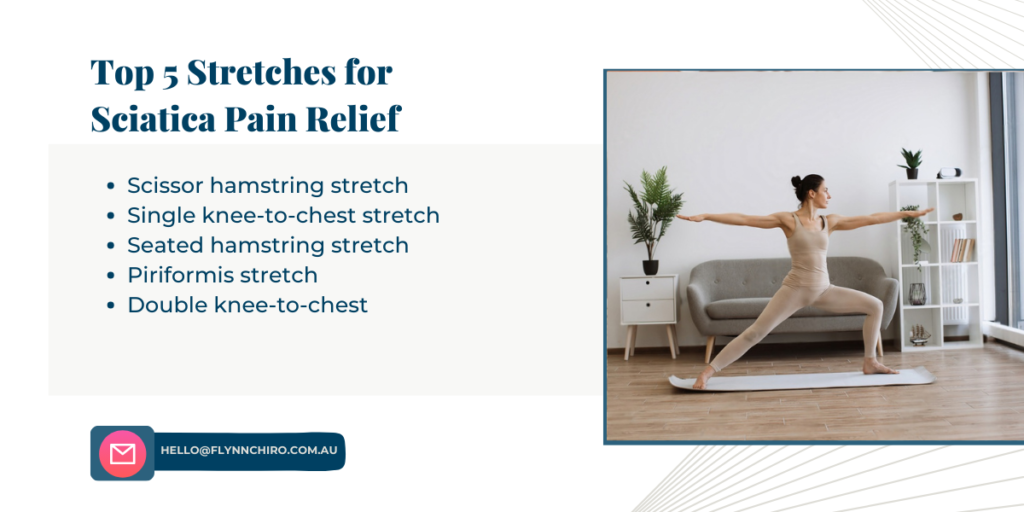
Best Exercises for Sciatica Pain Relief: Stretches and Strengthening
Sciatica is a common condition characterized by pain, numbness, or weakness radiating along the sciatic nerve, which runs from the lower back through the hips and buttocks and down each leg. The pain can range from mild to severe and is often caused by a herniated disc, bone spur, or spinal stenosis compressing part of the nerve.
While sciatica can be debilitating, certain exercises and stretches can provide relief by reducing pressure on the sciatic nerve. Continue reading to find the best exercises for sciatica pain relief.
Top 5 Stretches for Sciatica Pain Relief

Stretching exercises can help improve flexibility, reduce muscle tension, and alleviate pressure on the sciatic nerve. Perform these stretches gently and hold each position for 20-30 seconds, repeating on both sides.
1. Scissor hamstring stretch
Lie on your back with one leg extended and the other bent. Loop a towel or resistance band around the foot of the extended leg and gently pull it towards you, keeping the knee straight. Hold for 20-30 seconds, then repeat on the other side.
2. Single knee-to-chest stretch
Lie on your back with both knees bent. Bring one knee towards your chest, clasping your hands behind your thigh. Gently pull the knee closer to your chest until you feel a stretch in your lower back and gluteal muscles. Hold for 20-30 seconds, then repeat on the other side.
3. Seated hamstring stretch
Sit on the floor with one leg extended and the other bent, with the sole of your foot resting against your inner thigh. Reach forward towards your toes, keeping your back straight. Hold for 20-30 seconds, then repeat on the other side.
4. Piriformis stretch
Lie on your back with both knees bent. Cross one ankle over the opposite knee, creating a “figure 4” shape. Gently pull the bent knee towards your chest until you feel a stretch in your buttocks. Hold for 20-30 seconds, then repeat on the other side.
5. Double knee-to-chest
Lie on your back with both knees bent. Bring both knees towards your chest, clasping your hands behind your thighs. Gently pull your knees closer to your chest until you feel a stretch in your lower back. Hold for 20-30 seconds.
5 Best Strengthening Exercises
Strengthening the core, hip, and gluteal muscles can help support the lower back and reduce strain on the sciatic nerve. Perform these exercises 2-3 times per week, starting with 1-2 sets of 10-15 repetitions and gradually increasing as strength improves.
1. Bird-dog
Start on your hands and knees. Tighten your abdominal muscles, and lift your right leg and left arm at the same time, extending them straight out. Hold for 5-10 seconds, then lower back down. Repeat 10-15 times, then switch to the other side.
2. Bridge
Lie on your back with your knees bent and feet flat on the floor. Lift your hips off the ground until your knees, hips and shoulders form a straight line. Hold for 10 seconds, then lower down. Repeat 10-15 times.
3. Clamshell
Lie on your side with your knees bent and feet and hips stacked. Draw your knees in toward your body. Keeping your feet together, raise your top knee as high as you can without moving your bottom leg or pelvis. Pause, then return to the starting position. Repeat 10-15 times on each side.
4. Pelvic tilt
Lie on your back with your knees bent and feet flat on the floor. Tighten your abdominal muscles and flatten your lower back against the floor. Hold for 5-10 seconds, then relax. Repeat 10-15 times.
5. Lower trunk rotations
Lie on your back with your knees bent and feet flat on the floor. Keeping your shoulders flat on the ground, gently roll both knees to one side. Hold for 5-10 seconds, then return to the starting position and repeat on the other side.
Self-Care Tips to Relieve Sciatica Nerve Pain
In addition to stretching and strengthening exercises, there are other self-care measures that can help manage sciatica pain and prevent future flare-ups. Consider incorporating these tips into your daily routine:
- Walking and swimming are great low-impact aerobic exercises that can reduce inflammation.
- Avoid high-impact activities like running and exercises that require bending forward at the waist or twisting the spine, such as seated forward bends or aggressive trunk rotations.
- Maintain good posture and use proper body mechanics when sitting, standing and lifting.
- Apply heat or ice packs to the painful area for 10-15 minutes at a time, several times a day.
If sciatica pain persists or worsens despite these self-care measures, see your doctor or chiropractor. You may need imaging tests to determine the underlying cause and receive more targeted treatment such as physical therapy, medications, or in severe cases, surgery to relieve nerve compression.
With the right combination of exercises, stretches and other conservative treatments, most people with sciatica can find relief and prevent future flare-ups. The key is listening to your body, starting slowly, and being consistent with your self-care routine.

Flynn Pettersson
I am committed to providing exceptional chiropractic care in Melbourne, focused on your health and well-being.

Flynn Pettersson
I am committed to providing exceptional chiropractic care in Melbourne, focused on your health and well-being.






